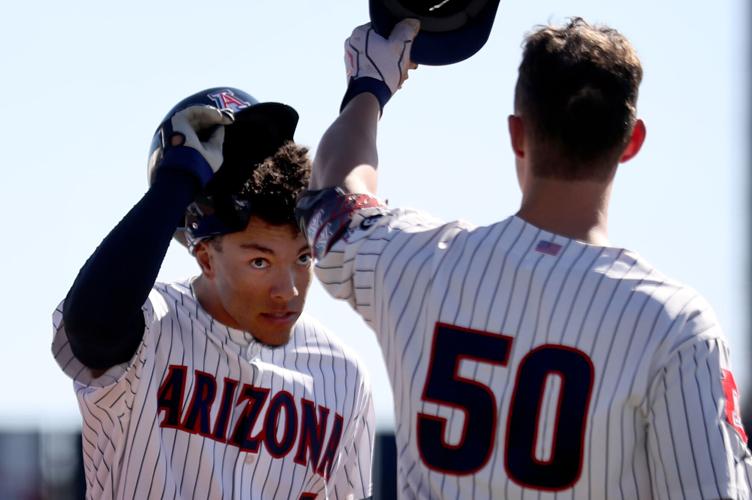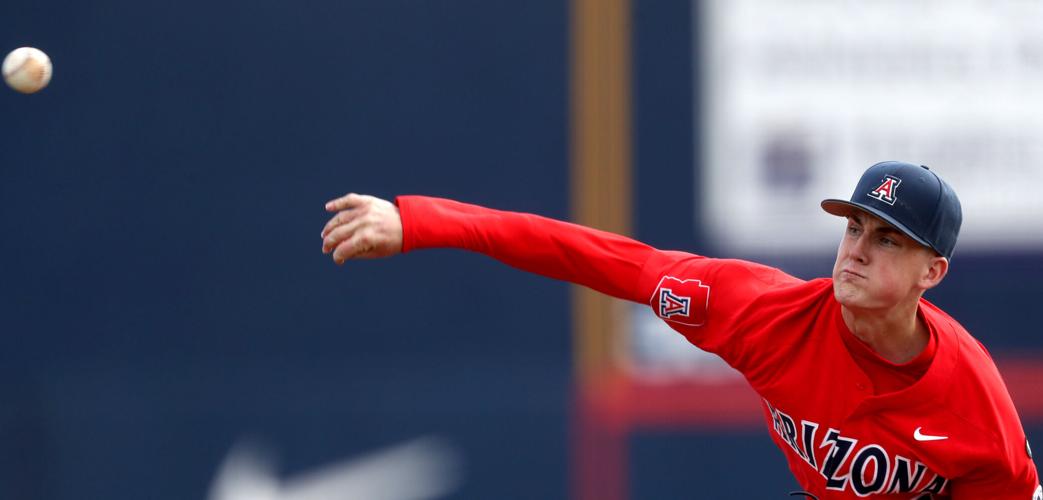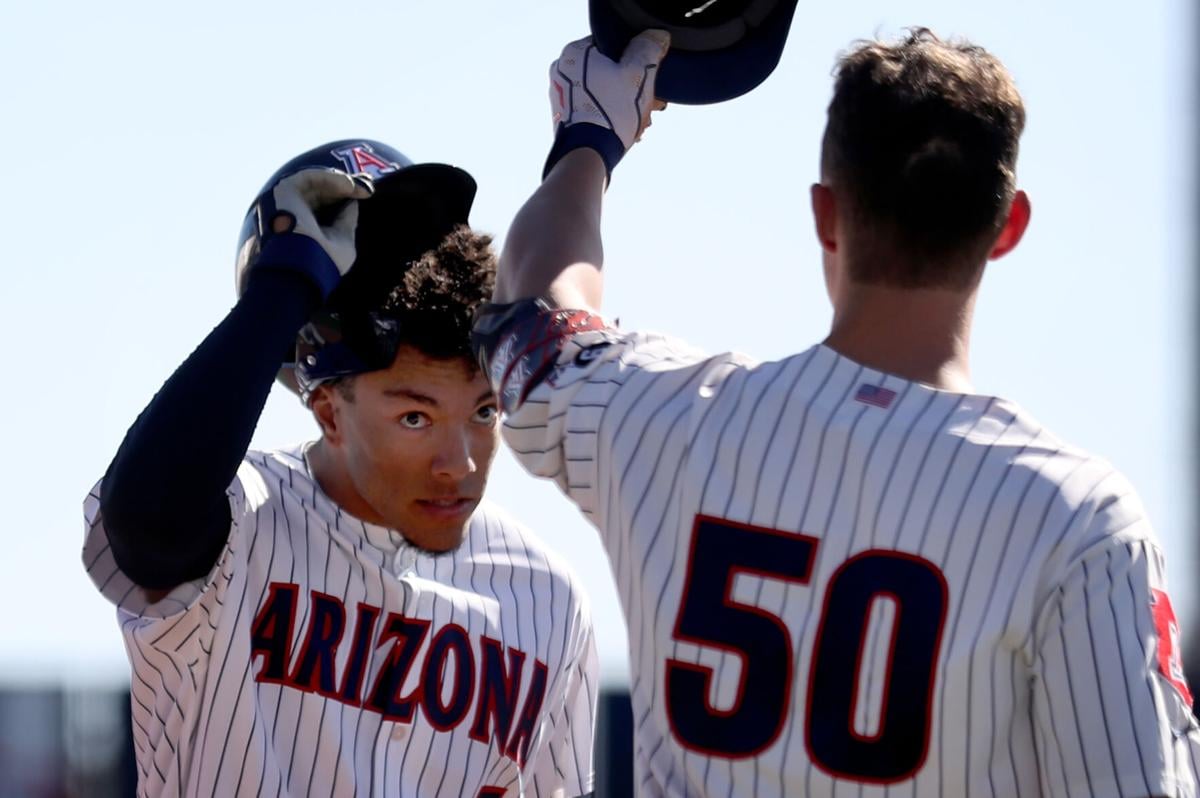More so than recent iterations, the 2022 Arizona Wildcats are all about potential and projection. They’re teeming with talent. But much of it remains unproven at this level.
No players personify that profile more than right-hander TJ Nichols and outfielder Chase Davis, a pair of toolsy sophomores with All-American upside.
Nichols is a 6-foot-4-inch power pitcher whose fastball has approached 100 miles per hour. Davis has every physical attribute you could want: power, speed and a strong throwing arm.
Both will take on new roles this season. After serving as a swingman as a freshman, Nichols is set to start Arizona’s opener Friday against Kansas State in the State Farm College Baseball Showdown in Arlington, Texas. After serving as a backup last year, Davis will start in left field.
Expectations for both are as massive as the Lone Star State. And their performances could determine whether the Wildcats make a return trip to the College World Series.
Baseball America picked Nichols as its Pac-12 Pitcher of the Year for 2022. It also ranked him as the No. 20 college prospect for the ’23 MLB draft. D1Baseball.com has Nichols 10th.
BA ranks Davis 33rd among college prospects for the ’23 draft. Entering the 2020 draft, the outlet had him 55th among all draft-eligible players.
Davis and Nichols (111th) were ranked higher than Daniel Susac and Jacob Berry, a pair of season-long starters who made every Freshman All-America team in 2021. Davis and Nichols are now poised to take their place alongside Susac as UA stars. (Berry transferred to LSU in the offseason.)
But nothing is guaranteed. Talent doesn’t ensure success. Production is all that matters in the bottom-line business of baseball.

Arizona right hander T.J. Nichols boasts a high-90s fastball and valuable experience gained from last year's run to the College World Series.
From thrower to pitcher
In Game 3 of the Wild vs. Cats Fall World Series in November, Nichols registered a peak velocity of 99.5 mph. It was easily the highest of any UA pitcher in the series.
“That’s gonna always catch people’s attention,” pitching coach Dave Lawn said. “Maybe two, three weeks into the fall, he started to pitch.”
Lawn compared Nichols’ progression from thrower to pitcher — which was also evident during his freshman season — to John Elway’s development as a quarterback. Elway threw so hard as a young player that the seams of the ball would leave an imprint on his receivers’ chests — the so-called “Elway Cross.” Once he learned how to put touch on the ball, Elway became a better quarterback.
“That’s really what TJ is doing,” Lawn said of Nichols, who also throws a slider and changeup.
Once he starts doing it consistently, Nichols will have a chance to reach what Lawn deemed a “very high ceiling.”
Nichols gave glimpses of that potential during his freshman year, when he struck out 66 batters in 60 1/3 innings. He allowed only 50 hits and posted a 6-3 record with a 4.77 ERA.
But he was a different, better pitcher over the second half of the season.
In his first nine appearances, covering 37 innings, Nichols posted a 6.81 ERA and a 1.70 WHIP. In his final eight appearances, spanning 23 1/3 innings, those numbers fell to 1.54 and 0.77.
Nichols’ role changed, from starter to reliever, and so did his command of the strike zone. Nichols lowered his BB/9 rate from 5.84 in those first nine games to 2.70 in the final eight. His K/9 rate barely budged, going from 9.73 to 10.03.
Nichols, 19, described his freshman season as “a little bit immature.”
‘I felt like throughout the season I got better,” said Nichols, who was a standout two-way player at Oakmont High School in Roseville, California. “It was just getting into college baseball and getting into a groove. I felt like I was in that at the end of season.”
Nichols relies on feedback from his teammates — including the hitters. He’ll often ask, “How would you criticize my outing?”
“I like to hear what they say,” Nichols said, “and improve next time.”
The message from first-year coach Chip Hale has been clear: Trust your stuff and pound the zone. Hale expects his Friday starter to pitch deep into games. Nichols’ career high is six innings.
“He needs to fill it up,” Hale said. “The guy that pitches Friday has to throw strikes. We need to see that.”
Nichols is on board. Asked if he pays attention to his radar readings, Nichols said:
“No, not really. I try and stay away from that. Right now, I think just working on command and control of the ball is where I need to focus.”
Power and patience
Davis possesses power of a different sort. He can hit the ball a long way.
Davis smashed three home runs in Saturday’s intrasquad scrimmage. All traveled more than 400 feet.
“He’s been locked in the last couple of weeks,” Hale said afterward.
Davis has made a slight adjustment to stay more “connected” at the plate — to make sure his hands maintain a tight, inside path to the ball. It seemed to be working during the scrimmage. Bigger tests await.
Despite his lofty credentials, Davis registered only 30 at-bats last season. The UA lineup was loaded. Then-coach Jay Johnson couldn’t find a spot for Davis, whom he dubbed a future “superstar.”
Davis notched seven hits, including four for extra bases, for a .233 average. He struck out 12 times. He viewed the season as a learning experience — an exercise in patience and selflessness.
“You never know what the situation is until you actually see it unfold in front of your eyes,” said Davis, 20, who prepped at Franklin High School in Elk Grove, California. “I had to adapt and adapt quickly. I felt like I did just that, and I feel like I handled the situation the best I could.”
Johnson never expected Davis to get to campus and all but dismissed the idea. But the 2020 draft was shortened to five rounds because of the pandemic, and many players who normally would have been picked ended up going to school.
Davis figured he could get bigger, stronger and faster at Arizona, which has a strong track record of developing pro players. Davis could put himself in a better position for the next time he was draft-eligible, as many Wildcats had done before him.
That he didn’t get to play as much as Susac or Berry as a freshman was something Davis had to accept.
“I (got) to see the rest of the team succeed, which I was very proud of,” said Davis, who served as the dugout’s preeminent hype man last season. “I felt like I was left out a little bit, but I told myself, ‘My time will come. Be patient.’”
After the CWS, Davis played for the La Crosse Loggers in the Northwoods League. Consistency remained elusive. Davis slugged four home runs in 120 at-bats but hit just .208. Nearly half of his hits went for extra bases, but he struck out 31 times. He also stole five bases without being caught.
“He has a beautiful swing,” Hale said of Davis, whose left-handed stroke has been compared to that of former MLB outfielder Carlos Gonzalez — who happens to be Davis’ favorite player. “We looked at a lot of video of him in summer ball. He really wasn’t having a lot of success. But his swing was good, so we had to figure out a way for him to put the ball in play.”
Davis’ challenge is similar to Nichols’ — harness the power, develop consistency, become a more polished player.
If both can do it, the Wildcats could have another special season.






